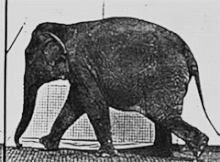Quadrupedie

The quadrupedie (lat. Quadrus four and pes foot) is the four-legged type of locomotion (locomotion) in terrestrial vertebrates. A mode of locomotion based on all four extremities is the plesiomorphic (primary, original) state for the terrestrial vertebrates (Tetrapoda), but was also acquired secondarily in some groups (e.g. ceratopside dinosaurs ).
An evolutionary advancement of the quadrupedie is the bipede , which occurs for example in hominids , some extinct crocodile relatives, many dinosaurs and birds .
Animals that by nature move on three legs (“triped”) are neither existing nor reported in the fossil record ; This is attributed to the fact that the four-legged locomotion of vertebrates is derived from bilaterally symmetrical fins of fish and that an asymmetrical reduction of the extremities apparently never had an evolutionary advantage. However, meerkats and other animals , for example, use their tails in an upright posture as a third “supporting leg”.
literature
- Achim Paululat, Günter Purschke: Dictionary of Zoology. 8th heavily revised and expanded edition, Spektrum Akademischer Verlag, Heidelberg 2011, ISBN 978-3-8274-2115-9 , p. 397
- Quadrupedie. Spektrum.de Lexicon of Biology. Spectrum Academic Publishing House, Heidelberg 1999
Individual evidence
- ↑ Tracy J. Thomson: Three ‐ Legged Locomotion and the Constraints on Limb Number: Why Tripeds Don't Have a Leg to Stand On. In: BioEssays. Volume 41, No. 10, 2019, Article No. 201900061, doi: 10.1002 / bies.201900061
- ↑ Why are there no animals with three legs? On: eurekalert.org from October 1, 2019.